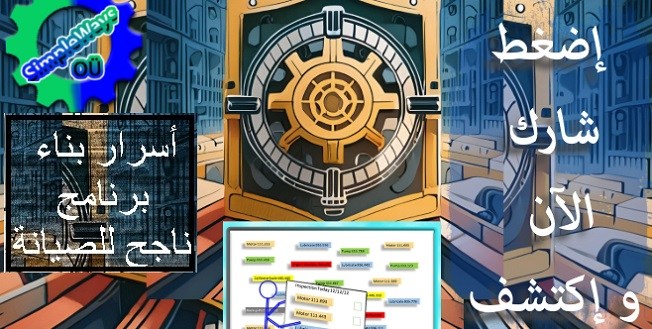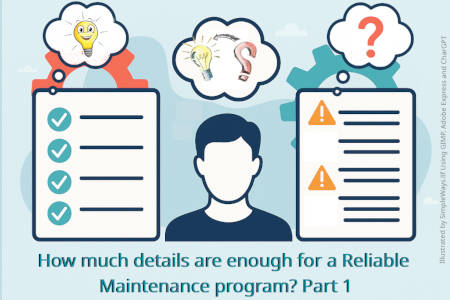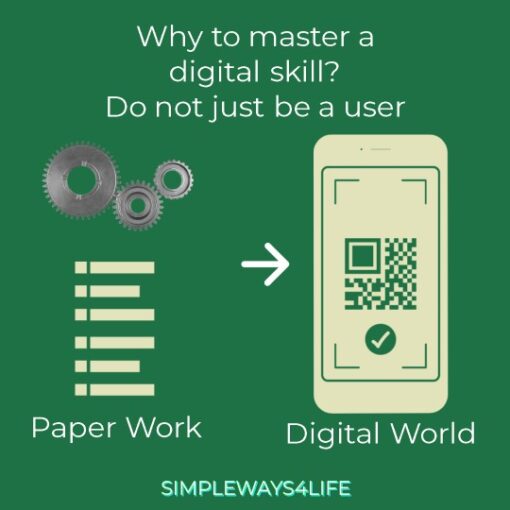Clear, detailed maintenance procedures are essential for effective execution in a Reliable Maintenance Program. Without proper detailing, even the best-trained teams can miss steps, waste time, or create safety risks. To ensure your maintenance procedures are understood and followed correctly, consider the following practical approaches:
- Use Step-by-Step Instructions
- Incorporate Visual Aids
- Leverage Digital Tools for Real-Time Updates
- Iterate and Adapt Based on Feedback
We are going to detail some of them in this article series. We had introduced the foundation steps of a strong maintenance program that doesn’t require complex software or large teams in the previous article. Starting with a clear, well-structured asset register—even one built in something as simple as Google Sheets—can bring clarity, accountability, and control to your operations. When paired with a flexible and evolving Maintenance Task Library, this foundation supports consistent maintenance practices, reduces downtime, and helps teams work smarter, not harder.
But the real power lies in how well tasks are understood and executed. That’s where task validation and detailing came in. They ensure that each task has a purpose, follows best practices, and is clear to those performing it. Let’s now delve deeper into how detailed a task might be.
That’s part of what we focus on in “Secrets of Building a Maintenance Program” That you can join from here

CUSTOMPRICE-TO2JAN26
How much detail in a step-by-step instruction is enough for Reliable Maintenance?
Clear instructions form the backbone of Reliable Maintenance. Without them, even skilled technicians may overlook critical steps. Even though, too little detail invites mistakes, too much detail can overwhelm or even paralyze the technician.
Instructions must balance clarity and brevity. For example, stating “Remove the filter” is vague. But “Remove the air filter using a 10mm socket; loosen counterclockwise for 3 full turns” may be too specific in some contexts.
Ask: What level of experience is expected? What Level of experience is available? If the task is basic, skip over-explaining. If it’s specialized, precision matters. How to find the skills needed for a task and how to specify the job description? That’s one of the important parts of “Secrets of Building a Maintenance Program“

CUSTOMPRICE-TO2JAN26
Break It Down Without Overloading
Breaking down tasks into manageable steps is essential for clarity and productivity. However, overloading each step with too many substeps can lead to confusion and mental fatigue.
Start by dividing the maintenance task into small, actionable steps. Each step should be simple and clear.
For example, instead of “Check the motor belts”, we need to “Isolate the motor, inspect for wear on belts, and check lubrication.”. We shall see in a moment how to make this properly detailed.
This prevents miscommunication and ensures tasks are executed the same way every time.
Here’s how global best practices support this approach:
Key Principles and Global Insights
Chunking (George A. Miller) [1]
Miller’s “magical number 7±2” shows that people hold 5 to 9 chunks in working memory. Compact steps improve focus. Overloaded ones break attention and cause mistakes.
Cognitive Load Theory (John Sweller) [2]
Minimize extra cognitive load. Long, complex steps slow understanding. Keep each action clear and purposeful.
Agile Methodology for Maintenance(A Rezika) [3]
Agile teams use short tasks. Each is small, clear, and trackable. The same logic applies to maintenance: small steps keep momentum and reduce errors.
Getting Things Done (David Allen) [4]
GTD promotes actions that are clear and executable. Tasks should not be too vague or overly detailed—just clear enough to move forward.
Nevertheless, these principles aren’t exclusive to maintenance—they come from psychology, productivity, and software development. Thinkers like George Miller and frameworks like agile weren’t built for maintenance. However, their insights help us in maintenance to work smarter. By borrowing proven concepts like chunking and iterative task breakdown, we make Reliable Maintenance more structured, more human-friendly, and ultimately more effective.
Tuning this Mindset is part of “Mindset Manifesto, The Blueprint to Work, Success and Tech“
Ready to transform your mindset? Click and Get your copy > Now For Sale on Simpleways.life & Amazon
Best Practices for Breaking Down Steps
- At First, Focus each step on a single action or decision.
- In other words, Avoid stuffing multiple operations into one instruction.
- Limit substeps unless absolutely required.
- Moreover, Use clear, active, and direct language.
- Lastly, Test steps with real users to verify clarity and flow.
Example: Overloaded vs. Clear Steps
Overloaded Step:
1-Open the panel, check the wiring for loose connections, measure voltage, tighten screws if needed, and close the panel.
Better Breakdown to steps:
⚠ 🔺Safety Notice🔺:
Always isolate power before opening electrical panels unless voltage checks are required. Use insulated tools and wear PPE.
- Open the electrical panel using appropriate safety gear.
- Check for loose wire connections.
- Measure voltage across terminals A and B.
- Tighten any loose screws using an insulated screwdriver.
- Close and secure the panel cover.
Can Too Much Detail Create Confusion?
Yes—especially when:
- There’s repetition or unnecessary steps.
- The instructions describe how without explaining why.
- The task includes unrelated roles or tools in the same instruction set.
Instead of one giant instruction, break it down into separate work instructions:
- Process A: Place Safety Condition and Disassemble unit
- Process B (HVAC specialist): Inspect coil integrity & unit condition
- Process C: Verify sensor(s) calibration
This makes the job manageable and logical. In Mastering The Reliability Mindset Training you can find some important keys for role setting.

CUSTOMPRICE-TO2JAN26
Role Distribution and Task Abstraction
Reliable Maintenance thrives when each role knows its exact responsibility.
Split tasks across disciplines when:
- Tools or skills differ (mechanical vs. electrical).
- Timing varies (e.g., wait for cooling before inspection).
- Compliance or certification is required (e.g., pressure vessel checks).
Use abstraction wisely:
- A step like “Verify system status with SCADA”
- assumes the reader understands how.
- If not, link to another guide or assign to a SCADA-operator.
This modularity keeps your main instruction lean but complete.
Final Thought
Effective step-by-step instructions for Reliable Maintenance don’t just tell someone what to do. They reflect who, how much, and when. That’s where reliability is born.
One post is never enough to show how to craft tasks but let’s keep it short and we shall continue in a coming article
If you feel you need help with any of these ideas we discussed, request a Management Consultancy or Coaching Services From our Store
References
- George A. Miller’s research on chunking and the magical number 7±2:
Miller, G. A. (1956). The magical number seven, plus or minus two: Some limits on our capacity for processing information. Psychological Review, 63(2), 81–97.
Link: https://labs.la.utexas.edu/gilden/files/2016/04/MagicNumberSeven-Miller1956.pdf - John Sweller’s Cognitive Load Theory:
Sweller, J. (1988). Cognitive Load During Problem Solving: Effects on Learning. Cognitive Science, 12, 257-285.
Overview: Cognitive load theory emphasizes reducing extraneous cognitive load to optimize learning and task performance.
Link: The importance of cognitive load theory (CLT) - The 8 Steps to create an Agile Maintenance :
How and why we need to reach an Agile Maintenance Process and an Agile Maintenance Team which has an Agile Mentality through the 8 steps needed to reach there.
Link : The 8 Steps to create an Agile Maintenance – Part 9 - David Allen’s Getting Things Done (GTD) Method:
Allen, D. (2002). Getting Things Done. Piatkus Books.
GTD is a productivity system that breaks work into actionable steps to reduce mental clutter and improve focus.
Summary and review: https://www.trig.com/reading-list/getting-things-done-the-art-of-stress-free-productivity










